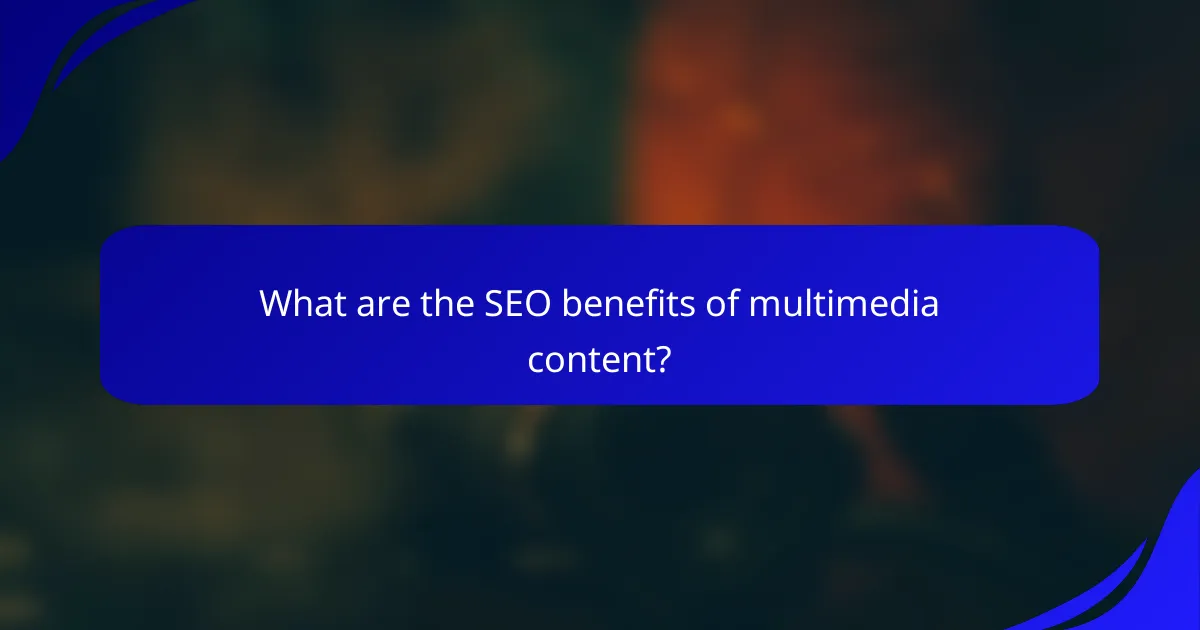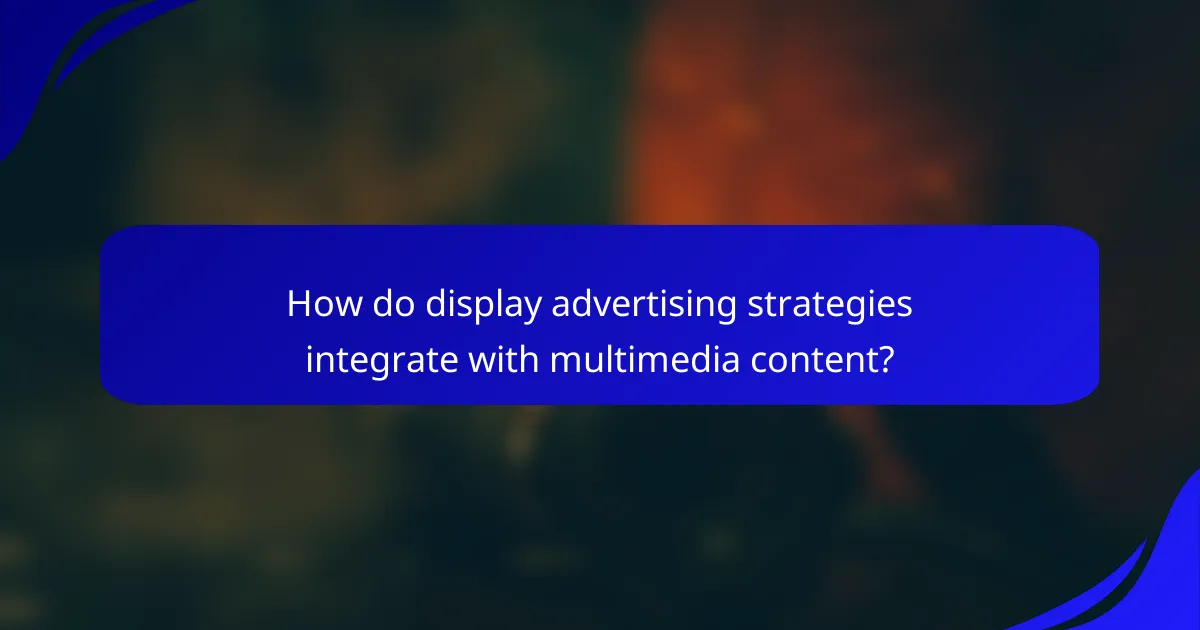Online publishing is transformed by the integration of multimedia content, which not only boosts user engagement but also enhances SEO performance. By utilizing videos, infographics, and podcasts, publishers can attract a broader audience and improve their search rankings. Additionally, analytics tracking offers valuable insights into user behavior, enabling publishers to refine their content strategies for greater impact and reach.

How does multimedia content enhance online publishing in the UK?
Multimedia content significantly enhances online publishing in the UK by increasing user engagement and improving SEO performance. Incorporating elements like videos, infographics, and podcasts can attract a wider audience and keep visitors on the page longer, which positively affects search rankings.
Engagement through videos
Videos are a powerful tool for boosting engagement in online publishing. They can convey complex information quickly and effectively, making them ideal for tutorials, product demonstrations, or storytelling. Research suggests that including a video on a landing page can increase conversion rates by up to 80%.
To maximize impact, ensure videos are concise, ideally between one to three minutes long, and include clear calls to action. Additionally, optimize video titles and descriptions with relevant keywords to enhance SEO benefits.
Interactive infographics
Interactive infographics are effective for presenting data in a visually appealing and engaging manner. They allow users to explore information at their own pace, which can lead to higher retention rates. In the UK, incorporating local statistics or trends can make the content more relatable and relevant to the audience.
When creating interactive infographics, focus on clarity and usability. Use simple navigation and ensure that the design is mobile-friendly, as a significant portion of users access content via smartphones. This can help improve user experience and lower bounce rates.
Podcasts for audience connection
Podcasts offer a unique way to connect with audiences by providing in-depth discussions on relevant topics. They allow for a personal touch, enabling listeners to feel more connected to the brand or publisher. In the UK, podcasts can cover local issues or trends, making them particularly appealing to a domestic audience.
To effectively leverage podcasts, maintain a consistent release schedule and promote episodes across various platforms. Engaging guests who are experts in their fields can also enhance credibility and attract more listeners. Aim for episodes to be around 20 to 40 minutes long to keep audiences engaged without overwhelming them.

What are the SEO benefits of multimedia content?
Multimedia content, such as images, videos, and audio, can significantly enhance SEO by improving user engagement and search visibility. By incorporating diverse formats, websites can attract more visitors and retain their attention, leading to better rankings on search engines.
Improved search rankings
Search engines prioritize websites that offer rich, engaging content. Multimedia elements can boost a site’s ranking by increasing its relevance and authority. For example, a blog post with relevant videos and images may rank higher than a text-only version, as search engines recognize the added value for users.
To optimize for search rankings, ensure that all multimedia is properly tagged with descriptive alt text and titles. This helps search engines understand the content and context, further enhancing visibility.
Increased dwell time
Dwell time refers to the amount of time a visitor spends on a webpage before returning to search results. Multimedia content can significantly increase dwell time, as users are more likely to engage with videos and interactive elements. A higher dwell time signals to search engines that the content is valuable, potentially improving rankings.
To maximize dwell time, consider embedding videos that summarize or elaborate on the text content. Aim for videos that are concise, ideally under five minutes, to maintain user interest without overwhelming them.
Enhanced keyword targeting
Multimedia content allows for more effective keyword targeting by providing additional opportunities to incorporate relevant terms. For instance, video descriptions, transcripts, and image captions can all include keywords that help improve search visibility.
When creating multimedia, conduct keyword research to identify terms that your audience is searching for. Use these keywords strategically in titles, descriptions, and tags to enhance the chances of appearing in search results.
![]()
How can analytics tracking optimize online publishing?
Analytics tracking can significantly enhance online publishing by providing insights into user interactions, content effectiveness, and overall audience engagement. By analyzing this data, publishers can make informed decisions to improve content strategy and increase reach.
Understanding audience behavior
Understanding audience behavior involves analyzing how users interact with published content. Key metrics such as page views, time spent on page, and bounce rates reveal what resonates with readers. For instance, if a particular article has a high engagement rate, it may indicate a strong interest in that topic.
Utilizing tools like Google Analytics can help identify demographic information, such as age and location, allowing publishers to tailor content to specific audience segments. This targeted approach can enhance user experience and drive higher engagement rates.
Measuring content performance
Measuring content performance is crucial for determining the effectiveness of published materials. Metrics such as shares, comments, and conversion rates provide a clear picture of how well content is performing. For example, a blog post that generates a high number of shares may indicate that it is valuable and engaging to readers.
Setting specific goals, such as increasing newsletter sign-ups or boosting social media shares, can help in evaluating content success. Regularly reviewing these metrics allows for timely adjustments to content strategies, ensuring alignment with audience preferences.
Adjusting strategies based on data
Adjusting strategies based on data involves using insights gained from analytics to refine content and marketing approaches. If certain topics consistently underperform, it may be wise to shift focus to more popular subjects. Additionally, experimenting with different formats, such as videos or infographics, can help capture audience interest.
Establishing a routine for reviewing analytics data—such as monthly or quarterly—can facilitate ongoing improvements. Avoiding reliance on assumptions and instead making data-driven decisions can lead to more effective content strategies and better audience engagement.
![]()
What tools are available for analytics tracking?
Several tools are available for analytics tracking, each offering unique features to help you understand user behavior and optimize your online content. The right choice depends on your specific needs, budget, and the level of detail you require in your analytics.
Google Analytics
Google Analytics is a widely used tool that provides comprehensive insights into website traffic and user behavior. It tracks metrics such as page views, session duration, and user demographics, allowing you to analyze how visitors interact with your content.
To get started, simply create an account, add the tracking code to your website, and begin collecting data. Google Analytics offers both free and premium versions, with the free version being sufficient for many small to medium-sized websites.
Adobe Analytics
Adobe Analytics is a robust analytics platform designed for larger enterprises that require advanced data analysis and reporting capabilities. It offers features like real-time data processing, segmentation, and predictive analytics, which can help you make informed decisions based on user behavior.
While Adobe Analytics provides powerful tools, it comes with a higher price tag and may require more technical expertise to implement effectively. Consider your organization’s size and analytics needs before choosing this option.
Hotjar for user insights
Hotjar is a user behavior analytics tool that focuses on visual insights, such as heatmaps and session recordings. It helps you understand how users interact with your site by showing where they click, scroll, and spend time, which can inform design and content decisions.
Hotjar offers a free basic plan, making it accessible for smaller websites, while paid plans provide more features and data storage. Use Hotjar alongside other analytics tools to gain a more holistic view of user engagement and improve your online presence.

What are the prerequisites for effective multimedia content creation?
Effective multimedia content creation requires a clear understanding of your target audience, technical skills for producing content, and knowledge of SEO for optimization. These elements work together to ensure that your content is engaging, accessible, and discoverable online.
Understanding target audience
Identifying your target audience is crucial for creating relevant multimedia content. This involves researching demographics, preferences, and behaviors to tailor your content accordingly. Knowing your audience helps in selecting the right format, tone, and messaging that resonates with them.
Utilize tools like surveys, social media analytics, and website metrics to gather insights about your audience. For instance, if your audience consists mainly of young adults, consider using platforms like Instagram or TikTok for video content, as these are popular among that demographic.
Technical skills for content production
Having the right technical skills is essential for producing high-quality multimedia content. This includes proficiency in graphic design, video editing, and audio production. Familiarity with software tools such as Adobe Creative Suite or Final Cut Pro can significantly enhance your content’s quality.
Additionally, understanding basic principles of design and storytelling will help you create engaging and coherent multimedia pieces. Consider taking online courses or tutorials to improve your skills, especially if you are new to content production.
SEO knowledge for optimization
SEO knowledge is vital for optimizing multimedia content to improve visibility in search engines. This includes understanding keywords, meta tags, and alt text for images and videos. Proper optimization ensures that your content reaches a wider audience and ranks higher in search results.
Incorporate relevant keywords naturally into your content and use descriptive titles and captions. Tools like Google Analytics can help track the performance of your content, allowing you to refine your SEO strategy over time. Avoid keyword stuffing, as it can negatively impact your content’s readability and search ranking.

How do display advertising strategies integrate with multimedia content?
Display advertising strategies effectively integrate with multimedia content by embedding ads within videos and forming partnerships for sponsored content. This approach enhances user engagement and can lead to higher conversion rates compared to traditional static ads.
Ad placements within videos
Ad placements within videos can take various forms, such as pre-roll, mid-roll, and post-roll ads. These placements allow advertisers to capture viewer attention at different stages of video consumption, maximizing visibility and impact.
When considering video ad placements, it’s crucial to balance ad frequency with viewer experience. Too many ads can lead to viewer drop-off, while well-timed placements can enhance brand recall. For example, mid-roll ads in longer videos often yield better engagement than pre-roll ads in shorter clips.
Sponsored content partnerships
Sponsored content partnerships involve collaboration between brands and content creators to produce engaging multimedia content that subtly promotes products or services. This strategy can enhance authenticity and trust, as the content often aligns with the audience’s interests.
Effective sponsored content should maintain a clear distinction between editorial and promotional elements. Brands should ensure that the content provides value to the audience, such as informative articles or entertaining videos, while seamlessly integrating their message. For instance, a cooking brand might partner with a popular chef to create recipe videos featuring their products.